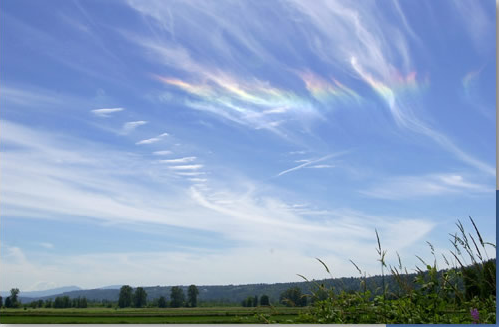Circumhorizon Arc & Mount Rainier
Circumhorizon Arc & Mount Rainier: A Stunning Atmospheric Phenomenon
Have you ever witnessed a mesmerizing display of colors in the sky? One such breathtaking sight is the Circumhorizon Arc (CHA) often seen in conjunction with the majestic Mount Rainier in Washington State. This natural phenomenon occurs when sunlight interacts with ice crystals in cirrus clouds, creating a vibrant arc of colors that spans across the sky.
Understanding the Circumhorizon Arc
The Circumhorizon Arc is a rare and captivating optical phenomenon that occurs due to the refraction of sunlight through ice crystals in cirrus clouds. These high-altitude clouds consist of tiny ice crystals that are shaped like flat plates or hexagonal columns. When sunlight passes through these crystals, it undergoes a process called refraction, where the light is bent as it enters and exits the crystal.
As the light refracts, it separates into its constituent colors, similar to how light is dispersed in a rainbow. The result is a stunning display of vivid colors, ranging from reds and oranges to blues and greens. The Circumhorizon Arc appears as a horizontal band of colors, parallel to the horizon, with its center positioned below the Sun.
The Influence of Mount Rainier
Mount Rainier, a prominent stratovolcano located in Washington State, often serves as the backdrop for the Circumhorizon Arc. Its towering presence adds to the allure of this atmospheric phenomenon, creating a picturesque scene that captivates onlookers.
When viewing the Circumhorizon Arc from Mount Rainier, the effect is particularly striking. The arc seems to emanate from the mountain itself, as if nature has painted a magnificent celestial pathway across the sky. This unique combination of the CHA and Mount Rainier makes for an unforgettable sight that attracts both locals and tourists alike.
The Extent and Appearance of the Circumhorizon Arc
The width of the Circumhorizon Arc can vary depending on the solar altitude, but it typically spans around 100°. This means that the arc can extend for a considerable distance across the sky, creating a breathtaking panorama. However, it is important to note that the appearance of the arc can be influenced by factors such as cloud cover and crystal orientation.
In some instances, the Circumhorizon Arc may appear curved, giving the illusion of rising from the horizon. However, this is merely a result of the camera projection and does not reflect the true shape of the arc. In reality, the CHA is uniformly positioned at the same height throughout its entire extent.
The HaloSim Simulation: Unveiling the Arc's Potential
To better understand the potential spread of the Circumhorizon Arc, researchers have developed simulations using HaloSim software. By assuming a uniform coverage of cirrus clouds containing well-formed plate-oriented ice crystals, these simulations reveal the full extent of the arc if the sky were completely covered by such clouds.
In these simulations, additional randomly oriented crystals are included to produce a reference 22° radius halo above the Circumhorizon Arc. This halo serves as a point of comparison and helps to showcase the unique characteristics of the CHA. By analyzing these simulations, scientists can gain valuable insights into the behavior and appearance of this captivating atmospheric phenomenon.
Witnessing the Circumhorizon Arc & Mount Rainier
If you find yourself in Washington State on a clear day with wispy cirrus clouds, keep an eye out for the stunning combination of the Circumhorizon Arc and Mount Rainier. To increase your chances of witnessing this breathtaking sight, it is best to observe when the Sun is high in the sky, preferably around midday.
Remember to bring your camera to capture this awe-inspiring natural spectacle. The vibrant colors and majestic backdrop provided by Mount Rainier will undoubtedly create memories that last a lifetime. So, be prepared to be amazed as you witness the harmonious dance of light and nature in the form of the Circumhorizon Arc and Mount Rainier.

Circumhorizon arc and Mount Rainier. Caught by David Johnston in wispy cirrus over Duvall, Washington State on 3rd July 2001, solar altitude 65°. Mount Rainier is at the lower left.

The HaloSim simulation at right shows how far the arc would spread if the sky were uniformly covered by cirrus cloud. containing well formed plate oriented crystals. David Johnston's image is 41° wide but the full extent of the CHA is some 100° depending on the solar altitude.
Some randomly oriented crystals were included in the simulation to produce the reference 22° radius halo above the CHA. The camera projection makes the CHA appear to curve upwards from the horizon. It is actually everywhere at the same height.
Note: this article has been automatically converted from the old site and may not appear as intended. You can find the original article here.
Reference Atmospheric Optics
If you use any of the definitions, information, or data presented on Atmospheric Optics, please copy the link or reference below to properly credit us as the reference source. Thank you!
-
<a href="https://atoptics.co.uk/blog/circumhorizon-arc-mount-rainier/">Circumhorizon Arc & Mount Rainier </a>
-
"Circumhorizon Arc & Mount Rainier ". Atmospheric Optics. Accessed on December 21, 2024. https://atoptics.co.uk/blog/circumhorizon-arc-mount-rainier/.
-
"Circumhorizon Arc & Mount Rainier ". Atmospheric Optics, https://atoptics.co.uk/blog/circumhorizon-arc-mount-rainier/. Accessed 21 December, 2024
-
Circumhorizon Arc & Mount Rainier . Atmospheric Optics. Retrieved from https://atoptics.co.uk/blog/circumhorizon-arc-mount-rainier/.